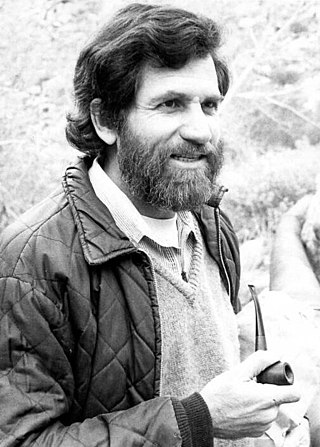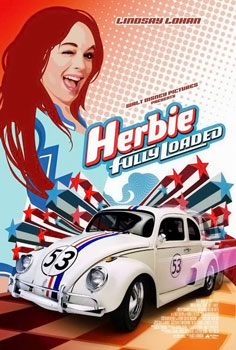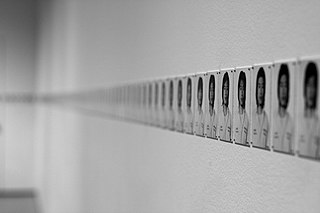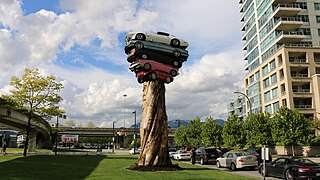| Trans-Fixed | |
|---|---|
 | |
| Artist | Chris Burden |
| Year | 1974 |
| Medium | Performance, documentary photographs |
Trans-Fixed was a 1974 performance by Chris Burden in which he was crucified onto a Volkswagen Beetle.
| Trans-Fixed | |
|---|---|
 | |
| Artist | Chris Burden |
| Year | 1974 |
| Medium | Performance, documentary photographs |
Trans-Fixed was a 1974 performance by Chris Burden in which he was crucified onto a Volkswagen Beetle.
On April 23, 1974, performance artist Chris Burden was crucified shirtless onto the back of a pale blue Volkswagen Beetle. [1] Burden stood on the car's rear bumper and leaned backwards. [2] His attorney hammered two nails through his open palms into the roof. Three other assistants ran the engine and opened the garage door, which opened into an alley called Speedway in Venice, California. [1] The assistants rolled the car out of the garage, where it ran while stationary for two minutes with the engine at full throttle. [2] Fifteen of his friends were there, having been invited but not briefed on what to expect. [1]
Burden later displayed relics from the performance, including a plaque alongside the two nails. [2]
The performance was religiously charged in its reference to the crucifixion of Jesus. Burden himself was not Catholic. Interpretations of the piece include Burden atoning for outcry against his prior body art works, or giving commentary on the forgotten connection between the "people's car" built by Nazi Germany. Art historians did not know whether to classify it as shamanistic or male egotism. [3]
The performance artist Marina Abramović sought to use the work in her Seven Easy Pieces but Burden denied her permission. [4]
Dale Eisinger of Complex described Trans-Fixed as Burden's most captivating work in his 2013 list of the greatest performance art works. [5] David Bowie's "Joe the Lion" alludes to Burden's performance. [6]

Volkswagen, (VW) is a German automobile manufacturer headquartered in Wolfsburg, Lower Saxony, Germany. Founded in 1937 by the German Labour Front under the Nazi Party and revived into a global brand after World War II by the British Army officer Ivan Hirst, it is known for the iconic Beetle and serves as the flagship brand of the Volkswagen Group, the largest automotive manufacturer by worldwide sales in 2016 and 2017. The group's biggest market is in China, which delivers 40 per cent of its sales and profits. Its name is derived from the German-language terms Volk and Wagen, translating to "people's car" when combined.

The Porsche 914 or VW-Porsche 914 is a mid-engined sports car designed, manufactured and marketed collaboratively by Volkswagen and Porsche from 1969 until 1976. It was only available as a targa-topped two-seat roadster powered by either a flat-4 or flat-six engine.

The Volkswagen Beetle—officially the Volkswagen Type 1, is an economy car that was manufactured and marketed by the German company Volkswagen (VW) from 1938 until 2003. It has a rear-engine design with a two-door body style and is intended for five occupants.

Milton Ernest "Robert" Rauschenberg was an American painter and graphic artist whose early works anticipated the Pop art movement. Rauschenberg is well known for his Combines (1954–1964), a group of artworks which incorporated everyday objects as art materials and which blurred the distinctions between painting and sculpture. Rauschenberg was both a painter and a sculptor, but he also worked with photography, printmaking, papermaking and performance.

Christopher Lee Burden was an American artist working in performance, sculpture and installation art. Burden became known in the 1970s for his performance art works, including Shoot (1971), where he arranged for a friend to shoot him in the arm with a small-caliber rifle. A prolific artist, Burden created many well-known installations, public artworks and sculptures before his death in 2015.

Cabaret Voltaire was the name of a short-lived artistic nightclub in Zürich, Switzerland in 1916. It was founded by Hugo Ball, with his companion Emmy Hennings, in the back room of Holländische Meierei, Spiegelgasse 1, on February 5, 1916, as a cabaret for artistic and political purposes. Other founding members were Marcel Janco, Richard Huelsenbeck, Tristan Tzara, and Sophie Taeuber-Arp and Jean Arp.

Heinz Heinrich Nordhoff was a German engineer who led the rebuilding of Volkswagen (VW) after World War II. He was featured on the cover of Time magazine on Feb. 15, 1954.

Rhythm 0 was a six-hour work of performance art by Serbian artist Marina Abramović in Naples in 1974. The work involved Abramović standing still while the audience was invited to do to her whatever they wished, using one of 72 objects she had placed on a table. These included a rose, feather, perfume, honey, bread, grapes, wine, scissors, a scalpel, nails, a metal bar, a gun, and a bullet.
Economy car is a term mostly used in the United States for cars designed for low-cost purchase and operation. Typical economy cars are small, lightweight, and inexpensive to both produce and purchase. Stringent design constraints generally force economy car manufacturers to be inventive. Many innovations in automobile design were originally developed for economy cars, such as the Ford Model T and the Austin Mini.

Allan Kaprow was an American performance artist, installation artist, painter, and assemblagist. He helped to develop the "Environment" and "Happening" in the late 1950s and 1960s, as well as their theory. His Happenings — some 200 of them — evolved over the years. Eventually Kaprow shifted his practice into what he called "Activities", intimately scaled pieces for one or several players, devoted to the study of normal human activity in a way congruent to ordinary life. Fluxus, performance art, and installation art were, in turn, influenced by his work.

Herbie: Fully Loaded is a 2005 American sports comedy film directed by Angela Robinson from a screenplay by Thomas Lennon, Robert Ben Garant, Alfred Gough, and Miles Millar. The film is the sixth and final installment in the Herbie film series, following the television film The Love Bug (1997), and the first theatrical film since Herbie Goes Bananas (1980). It serves as a direct sequel to the previous films. The film stars Lindsay Lohan, Justin Long, Breckin Meyer, Matt Dillon, and Michael Keaton. It features cameos by many NASCAR drivers, including Jeff Gordon, Jimmie Johnson, Tony Stewart, and Dale Jarrett.

Herbie, the Love Bug is a sentient 1963 Volkswagen Beetle, who has been featured in several Walt Disney motion pictures starting with the 1969 feature film The Love Bug. He has a mind of his own, is capable of driving himself, and is often a serious contender in auto racing competitions. Throughout most of the franchise, he is distinguished by red, white, and blue racing stripes from the front to the back bumper, a pearl white body, a racing-style number "53" on the front luggage compartment lid, doors, engine lid, and a yellow-on-black 1963 California license plate with the registration "OFP 857".
"Joe the Lion" is a song by David Bowie in 1977 for the album "Heroes". It was produced by Bowie and Tony Visconti and features lead guitar by Robert Fripp.

Tehching (Sam) Hsieh is a Taiwanese-born performance artist. He has been called a "master" by fellow performance artist Marina Abramović.

Dr. Ing. h.c. Rudolf Leiding was the third post-war chairman of the Volkswagen automobile company, succeeding Kurt Lotz in 1971.
Seedbed is a performance piece first performed by Vito Acconci on 15–29 January 1972 at Sonnabend Gallery in New York City.

The Volkswagen Golf Mk1 is the first generation of a small family car manufactured and marketed by Volkswagen. It was noteworthy for signalling Volkswagen's shift of its major car lines from rear-wheel drive and rear-mounted air-cooled engines to front-wheel drive with front-mounted, water-cooled engines that were often transversely-mounted.

Crucifixions and crucifixes have appeared in the arts and popular culture from before the era of the pagan Roman Empire. The crucifixion of Jesus has been depicted in a wide range of religious art since the 4th century CE, much of which has included the appearance of mournful onlookers, the Virgin Mary, angels, Pontius Pilate and even antisemeitc depictions of deicidal Jews. In more modern times, crucifixion has appeared in film and television as well as in fine art, and depictions of other historical crucifixions have appeared as well as the crucifixion of Christ. Modern art and culture have also seen the rise of images of crucifixion being used to make statements unconnected with Christian iconography, or even just used for shock value.

Trans Am Totem was a public art installation in Vancouver, British Columbia, Canada, created by sculptor Marcus Bowcott. Part of the Vancouver Biennale, the piece was unveiled in April 2015. Located at the intersection of Quebec Street and Milross Avenue, near False Creek, east of Vancouver's Downtown area, the sculpture incorporated stacked cars on top of a base made from a tree trunk. It stood 10 metres (33 ft) high and weighed 11,340 kilograms (25,000 lb). It was dismantled on August 15, 2021, to be restored and reinstalled in a new location by the summer of 2022.

Shoot was a 1971 performance by Chris Burden, in which he arranged to have himself non-lethally shot.